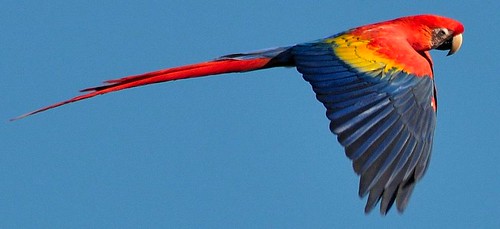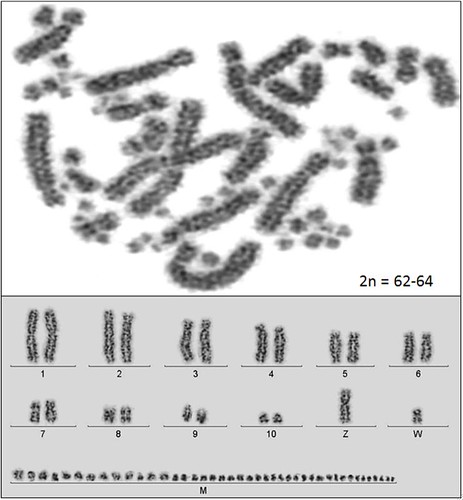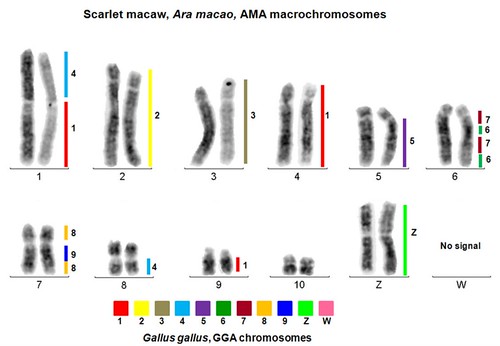Journal Club: Scarlet macaw genome sequenced
SUMMARY: The newly-sequenced scarlet macaw genome will provide many important insights into avian and human biology, behaviours and genetics and will contribute to parrot conservation.

Scarlet macaw, Ara macao, in flight.
Image: Tambopata Research Center. [NOTE: This image has been altered; it has been cropped.]
 After many years of research into the behaviours, diseases, genetics and life history of scarlet macaws, a team of scientists have taken their studies to the next level. Christopher Seabury, an Assistant Professor of Genetics at Texas A&M University’s college of Veterinary Medicine and Biomedical Sciences, and Ian Tizard, Director of the Schubot Exotic Bird Health Center and a Professor of Microbiology & Immunology at Texas A&M University’s college of Veterinary Medicine and Biomedical Sciences, spearheaded an international collaboration of scientists that sequenced the genome of the scarlet macaw, Ara macao. This work significantly expands the range and depth of research opportunities involving scarlet macaws and other parrots. In addition to important conservation applications, this research may provide insights into the genetics that contribute to key traits of parrots, such as cognitive and speech abilities as well as longevity.
After many years of research into the behaviours, diseases, genetics and life history of scarlet macaws, a team of scientists have taken their studies to the next level. Christopher Seabury, an Assistant Professor of Genetics at Texas A&M University’s college of Veterinary Medicine and Biomedical Sciences, and Ian Tizard, Director of the Schubot Exotic Bird Health Center and a Professor of Microbiology & Immunology at Texas A&M University’s college of Veterinary Medicine and Biomedical Sciences, spearheaded an international collaboration of scientists that sequenced the genome of the scarlet macaw, Ara macao. This work significantly expands the range and depth of research opportunities involving scarlet macaws and other parrots. In addition to important conservation applications, this research may provide insights into the genetics that contribute to key traits of parrots, such as cognitive and speech abilities as well as longevity.
Scarlet macaws are large and showy parrots with brilliant red, yellow and blue plumage and long pointed tails. Endemic to Central and South America, this impressive neotropical parrot occupies a large range from southeastern Mexico throughout the Amazon basin region of Peru, Bolivia and Brazil. Easily trained to do complex tasks and to mimic human speech, wild scarlet macaws have been persecuted by the caged bird trade. Additionally, their preferred habitat of lowland evergreen rainforests makes them vulnerable to deforestation and habitat destruction.
To do this work, Drs Seabury and Tizard and their team obtained a blood sample from an adult female scarlet macaw known as “Neblina” who resides at the Blank Park Zoo in Iowa. A wild-caught parrot from Brazil, Neblina had been seized in 1995 by the US Fish and Wildlife Service after she illegally entered the United States.
Unlike mammals, avian red blood cells are nucleated, so a small sample of whole blood from a bird is an excellent source of DNA for molecular, chromosomal and cytological studies. Some cells were grown in cultures so the intact chromosomes could be harvested and examined whilst DNA was extracted from other cells for sequencing. These gene sequences were then assembled into the complete scarlet macaw genome by Seabury and his team.
Similar to almost all vertebrates, scarlet macaws are diploid; having two copies of each chromosome type, one contributed by each parent. Like all birds except birds of prey (Falconiformes), parrot genomes contain macrochromosomes and a larger number of microchromosomes.
Macrochromosomes are what most people think of when they hear the word “chromosome” and they are the type of chromosomes that are typically found in mammals. Macrochromosomes, which include autosomes and sex chromosomes, are large — generally more than 40 megabases (Mb) in size (1 megabase is 1,000,000 nucleotide basepairs in length).
Microchromosomes, on the other hand, are very small — usually less than 20 Mb in size. Due to their small size, microchromosomes are often impossible to distinguish when creating a traditional karyotype, as you see in Figure 1 (larger view):

Figure 1. Consensus Scarlet Macaw (Ara macao) Karyotype.
Scarlet macaw diploid chromosome number is 2n=62–64, as inferred from chromosome counts of multiple cells derived from three individuals, including the sequenced female macaw (Neblina). All investigated scarlet macaws had 22 macrochromosomes, which included 10 pairs of autosomes and the sex chromosomes, and approximately 40–42 microchromosomes. [doi:10.1371/journal.pone.0062415.s019]
To identify similar regions between scarlet macaw and chicken macrochromosomes, the team used chromosome painting. This method uses fluorescently labeled chromosome-specific DNA probes that hybridise to complementary DNA regions, thereby identifying macaw chromosome regions that are similar to chicken chromosomes (Figure 2; larger view):

Figure 2. Chicken-Scarlet Macaw (Ara macao) Comparative Chromosome Painting (ZooFISH).
Using chicken flow sorted macrochromosomes (GGA1-GGA9) as well as GGAZ and GGAW, the homologous chromosome segments of the scarlet macaw were established via fluorescent in situ hybridization. [doi:10.1371/journal.pone.0062415.s019]
As typical for other avian genomes studied so far, scarlet macaw genomes are smaller than mammalian genomes.
“The final analysis showed that there are about one billion DNA bases in the genome, which is about one-third of that found in mammals,” Dr Tizard explained in a written press release.
“Birds have much less DNA than mammals primarily because they do not possess nearly as much repetitive DNA.”
Repetitive DNA has no currently known function. The amount of repetitive DNA varies greatly between taxa: for example, more than 50 percent of the human genome is repetitive DNA [doi:10.1038/nrg3117].
According to Dr Seabury, comparing the scarlet macaw genome to other avian genomes will provide scientists with a better understanding of avian biology.
“The Scarlet Macaw Genome Project opens a variety of doors ranging from modern forensics to determining how the macaws utilize their natural habitat and landscape, as inferred from variable genetic markers,” said Dr Seabury in a written press release.
In addition to research into evolution and population genetics, and conservation biology applications, what can we learn from the scarlet macaw’s genome? First, even though birds have higher metabolisms than mammals, they enjoy much longer life spans than do mammals with the same body mass. In the case of scarlet macaws, adults weigh somewhere between 1000 and 1200 grams (roughly 2.2 pounds), and they reach sexual maturity at 5 years of age, yet their life span rivals that of humans. By comparing avian genomes to those obtained from other animals, it may be possible to identify which genes contribute to birds’ remarkable longevity.
Other genes of interest are those involved in heart and cardiovascular fitness, and those that contribute to the risk for diabetes. But perhaps most interesting are those genes involved with cognition and brain size.
“A preliminary analysis of their genome suggests that [macaws] have a lot of genes involved in brain development”, said Dr Tizard in a video press release. “Which fits, knowing how smart they are.”
Despite differences from humans in brain development and structure, macaws are much like humans: they are very intelligent and live in highly complex social groups. Additionally, when corrected for differences in body size, macaws’ brains are twenty-one percent larger than those of zebra finches, Taeniopygia guttata, which are the model system for vertebrate learning and memory. Thus, comparing the scarlet macaw, zebra finch and human genomes could provide greater insight and understanding into important genetic differences in brain development, structure and volume.
NOTE: this piece is slightly edited from the original, which was published on the Guardian.
Sources:
Seabury C.M., Dowd S.E., Seabury P.M., Raudsepp T., Brightsmith D.J., Liboriussen P., Halley Y., Fisher C.A., Owens E. & Viswanathan G. & Tizard, I.R. (2013). A Multi-Platform Draft de novo Genome Assembly and Comparative Analysis for the Scarlet Macaw (Ara macao), PLoS ONE, 8 (5) e62415. doi:10.1371/journal.pone.0062415.s019
TAMU written and video press releases.
Also cited:
Treangen T.J. & Salzberg S.L. (2012). Repetitive DNA and next-generation sequencing: computational challenges and solutions, Nature Reviews Genetics 13: 36-46. doi:10.1038/nrg3117
Ried T., Schröck E., Ning Y. & Wienberg J. (1998). Chromosome painting: a useful art, Human Molecular Genetics, 7 (10) 1619-1626. doi:10.1093/hmg/7.10.1619 [OA PDF]
.. .. .. .. .. .. .. .. .. .. ..
GrrlScientist is an evolutionary biologist, ornithologist and freelance science writer who writes about the interface between evolution, ethology and ecology, especially in birds. As a judge who helped select the 2013 Royal Society Young People’s Book Prize shortlist, she also has a deep passion for good books, especially good science books, which she reviews with some regularity. You can follow Grrlscientist’s work on her eponymous Guardian blog, and also on facebook, G+, LinkedIn, Pinterest and of course, twitter: @GrrlScientist
